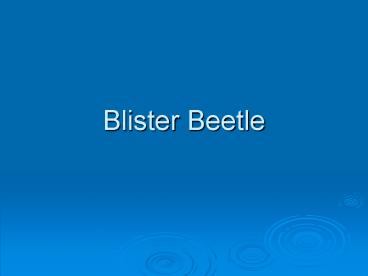Blister Beetle - PowerPoint PPT Presentation
1 / 9
Title:
Blister Beetle
Description:
Blister Beetle The family Meloidae, blister beetles, contains about 2500 species, divided among 80 genera and three subfamilies Description: Blister beetles vary by ... – PowerPoint PPT presentation
Number of Views:163
Avg rating:3.0/5.0
Title: Blister Beetle
1
Blister Beetle
2
- The family Meloidae, blister beetles, contains
about 2500 species, divided among 80 genera and
three subfamilies
3
Description
- Blister beetles vary by species in shape, size
(3/8 to 1 inch long) and color (solid gray to
black or with paler wing margins, metallic,
yellowish striped or spotted). - Most are long, cylindrical narrow-bodied beetles
that have heads that are wider than the first
thoracic segment (pronotum). The wing (elytra)
covers are usually soft and pliable.
4
- Although over 100 species occur in Texas, common
blister beetles include, the black blister
beetle Epicauta pennsylvanica (De Geer), E.
occidentalis (east and central Texas) and E.
temexa (south Texas) are mostly orangish-yellow
with three black stripes on each of the wing
covers (elytra). A west Texas species,
Cysteodemus armatus LeConte, has wing covers that
are broadly oval and convex, colored black with
bluish or purplish highlights.
Blister beetles,Epicauta sp.(Coleoptera
Meloidae),mating on Texas mountain laurel.Photo
by Drees
5
Life Cycle
- Complete metamorphosis hypermetamorphosis.
Winter is spent in later larval stages and
pupation occurs in the spring. The pupal stage
lasts about 2 weeks and adults appear in early
summer. Female beetles lay clusters of eggs in
the soil. The first stage (instar) larva hatching
from the egg (triungulin) is a tiny, active,
long-legged larva that seeks the appropriate
host.
Blister Beetle Life CycleA adult, E egg, T
first instar or triungulin, FG first grub
phase,C coarctate phase in instar six or
seven, SG second grub phase, P pupa
6
Habitat and Food Source(s)
- Mouthparts are for chewing. Blister beetle
species feed on flowers and foliage of a wide
variety of crops including alfalfa, ornamental
plants, potatoes, garden vegetables and other
plants.
Black blister beetle,Epicauta pennsylvanica
(DeGeer)(Coleoptera Meloidae),on goldenrod
flowers.Photo by Drees
7
Medical and Veterinary Importance
- Blister beetles receive their common name from
the ability of their hemolymph to produce
blistering on contact with human skin. Hemolymph
is often exuded copiously by reflexive bleeding
when an adult beetle is pressed or rubbed.
Blisters commonly occur on the neck and arms, as
the result of exposure to adult beetles attracted
to outdoor lights at night.
8
Pest Status
- Adults usually occur in loose groups or swarms
that feed on leaves of certain plants, especially
legumes. Their bodies contain a toxin
(cantharadin) that can cause blisters to form on
the skin. Animals, particularly horses, ingesting
beetle contaminated feed become extremely ill and
may die. Handling blister beetles can cause
blisters on the skin as a reaction to cantharadin
9
- Cases of fatal poisonings of valuable horses in
Florida, Oklahoma, Tennessee, and Texas by
ingestion of blister beetles trapped in baled
alfalfa hay































